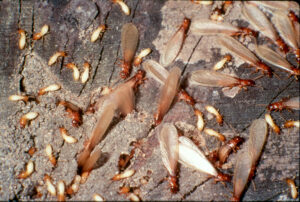
By Cole Sikes
AUBURN UNIVERSITY, Ala. – Termite swarm is inevitable each year. This season’s emergence has occurred later than expected according to professionals. Understanding environmental cues that may trigger termite swarming can save you time and money.
What is a termite swarm?
Spring is typically peak swarming season of termites. However, it can happen at any time of the year if the environmental conditions are right.
“A termite swarm is defined as the initial first flight of the winged adults,” said Alabama Cooperative Extension System Entomologist Xing Ping Hu. “These insects disperse to find mates, new nesting locations and create new colonies. This process is fast and if happens to your home, it is an unforgettable experience.”
Environmental Cues
This explosive spread of termites does not ignite randomly. They also do not move in synchrony across Alabama. Certain environmental conditions will trigger winged termites to fly from their in-ground nests.
Swarming termites will not harm you, nor do they damage homes or belongings. Most of the insects die from environment conditions or predators such as birds, spiders or other insects.
“The presence of swarming termites is undoubtedly unpleasant,” Hu said. “It is most important for a consumer to realize that any swarm survivors have the potential to form new colonies and infest homes and other property.”
Termite Research
Research shows that, in Alabama, peak swarming months are April through July. Scientific observation shows that termites require certain heat units before swarming occurs. This measurement correlates to regional climate differences in the United States.
Once the insects obtain the necessary amount of heat units, a swarm does not automatically occur. So, winged adults will wait for the trigger of a rain event. After a precipitation event, swarming usually happens within one to three warm and calm days.
“Homeowners should watch for rain events with the expectation there may be swarms in the next few days,” Hu said.
What Property Owners Must Know
Hu says if termites are swarming around the outside of a home, an inspection is necessary. Locating the source of the swarm is key when diagnosing a termite problem.
Common colony locations can be tree stumps, logs or even your home. If termites are already swarming inside a house, there is most likely already an existing infestation. Contact termite specialists to conduct an inspection.
Here are few tips if termites are inside your home:
- Close off the room in which the insects are swarming
- Collect a few termites to show your professional inspector
- Use a vacuum cleaner to remove insects after they have swarmed
- If possible, note the exact locations from which the swarmers are emerging
- Professionals apply chemicals for termite control most effectively
More Information
For more information on termites and how to protect your home, please visit the Alabama Extension website at www.aces.edu.

















